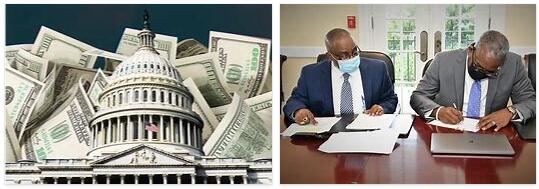United States Public Finance
A notable improvement in the economic situation occurred in 1936, ending with unemployment decreased by 31% compared to 1935 and national income increased by 16% (although still below the level reached in 1929).
Undoubtedly, however, the expansion of credit contributed to the recovery – fueled both by the continuous increase in public debt, largely placed with banks, and by the immigration of foreign capital, especially as a consequence of global economic and political instability – and the dubious solidity of the system. banking was beginning to cause serious concern. The Board of Governors then proceeded to gradually raise the percentages of the legal reserve of the banks affiliated to the RS (doubled in three stages: August 1936, March and May 1937) and with 21 December of the same year began a policy of sterilization of gold, inspired by to the system adopted by the British Equalization Fund, by purchasing gold from federal and private banks through Treasury bills and placing it in a special inactive account. refimding loans on favorable terms; and to ensure the availability of low-rate bank credit, as well as to avoid an undue and dangerous expansion of credit itself, it continued to be addressed even during 1937. Since the spring of 1937, however, the situation had rapidly changed and the year, which began with very high production, confidence, prices, wages and rising profits, closed with share values that fell back to half the level of 1936, production decreased by 30%, and unemployment on the rise (estimates range between 7 and 12 million). As a consequence of the changed situation already at the end of 1937 the Treasury decided to release 300 million sterilized gold, from the beginning of 1938 then substantially changed its policy in terms of treasury and in April, to finance both the public works and the welfare program, he abolished the inactive fund, then 1.4 billion, replacing the Treasury bills issued against the gold set aside with gold certificates. In the same month, the compulsory coverage margin of bank deposits, which had previously doubled, was also reduced by 12.5%, thus allowing a further expansion of credit.
It is natural that in these conditions and also given the new armament programs, it was not possible to further reduce budget expenditures – despite the importance attached to achieving balance, also to avoid the risk of credit inflation inherent in the enlargement of the debt. public -, while the contraction in business resulted in a decrease in revenues. In fact, the deficit for 1937-38 in the established forecasts is still 1.3 billion, while in the first forecasts it could have been reduced to less than 400 million. The action of the government, it is said in the presidential message of January 3, 1938, given the rigidity of many fixed charges, must focus on increasing revenues and therefore on increasing national income which, already passed from 38 billion in 1932 to 68 in 1937, it must aim to reach 90-100 in the shortest possible time. The solution of various and complex problems, both international and above all connected to government intervention in the economy and to the collaboration between capital and labor, is however a necessary premise for the success of the Roosevelt plan.
And here are the financial management figures for the last few years (in millions of dollars).
At 30 June 1937, the consolidated public debt was 21.8 billion and the floating one 14.6; overall, as of June 30, 1938, it had then reached 37.6 billion.
As of May 31, 1938, the circulation amounted to a total of 9951 million and was made up as follows: gold certificates 2895; silver dollars 43; silver certificates 1484; Treasury notes 1890; United States notes 344; Federal Reserve notes 4415; Federal Reserve Bank Notes 31; National Bank notes 222; 364 silver subsidiary coins; divisional coins 152. The gold reserves at the same date were 12,915 million.
With the banking law of 1935, which entered into force on 1 March 1936, the FRB took the name of the Board of Governors of the FRS. power to oblige affiliated banks to double their liquid reserves to guarantee term and sight deposits, and regulate the rate of money every fortnight, approving the discount rates proposed by the individual Federal Reserve Banks. The Fed. Open Market Committee was also created (made up of 7 members of the Board and 5 presidents of the Federal Reserve Banks), with the task of guiding the Federal Reserve Banks in securities operations; Federal Reserve Banks have been authorized to grant loans on “paper” at 4 months and the National Banks to carry out operations on real estate properties up to 50% of the value of the property and for no more than 5 years; the Fed. Dep. Ins. Corporation, transformed into a permanent institution, was also entrusted with the supervision of all the State Banks affiliated to it and not participating in the Federal Reserve system and possibly also of the others; Banks with deposits of over $ 1 million were required to apply for admission to the Federal Reserve System by 1941.



